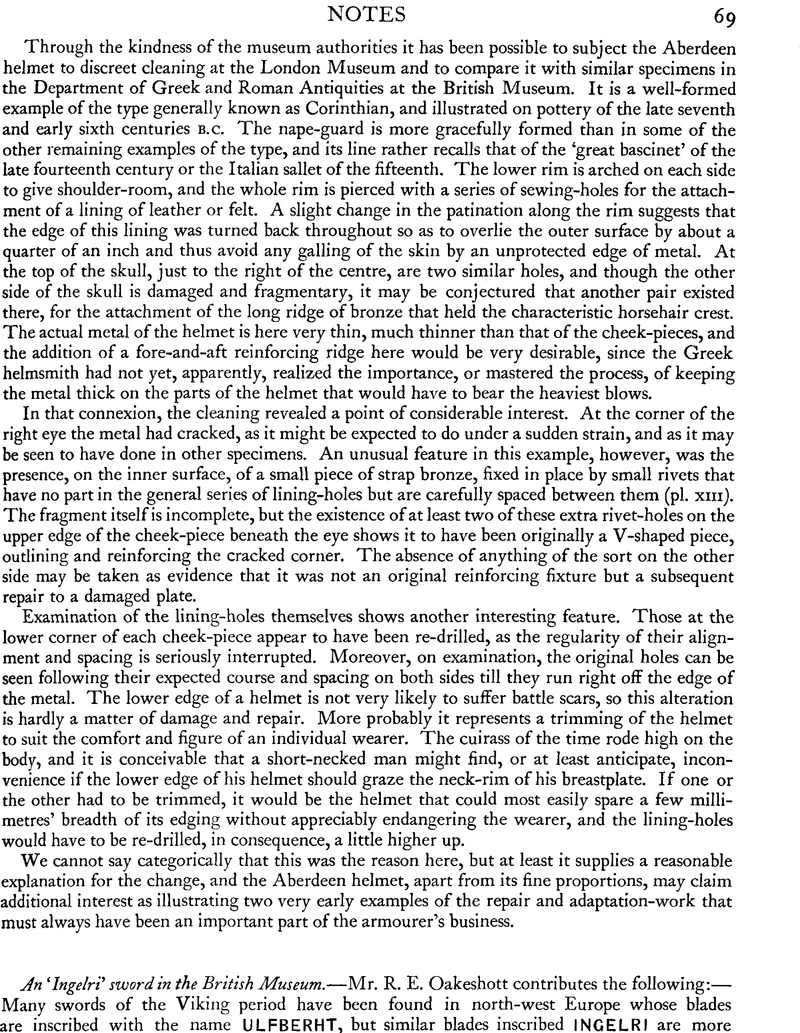Article contents
An ‘Ingelri’ sword in the British Museum
Published online by Cambridge University Press: 29 November 2011
Abstract

- Type
- Notes
- Information
- Copyright
- Copyright © The Society of Antiquaries of London 1951
References
page 70 note 1 Lorange, A. L., Den Yngre Jernalders Svœrd, 1889Google Scholar; Petersen, Jan, De Norske Vikingesverd, 1919Google Scholar; Wegeli, R., ‘Inschriften auf Mittelalterliche Schwertklingen’, Zeitschrift für historische Waffenkunde, iii, pp. 177 and 218.Google Scholar
page 70 note 2 Den Yngre Jernalders Svesrd and Wegeli, Z.H.W.K. iii.
page 70 note 3 H. Arbmann, Z.H.W.K. 1935–6.
page 70 note 4 Now in the museum at Nantes, Bulletin de la Société Archéologique de Nantes et de la Loire Infériure, 1929, p. 121.
page 70 note 5 Found near Novgorod. Now in the History Museum in Moscow. Arndt, W., Mannus, xxv, 1933.Google Scholar
page 70 note 6 Hanover State Museum, no. 2 81.3 2, and in the Armee Museum in Munich. The third used to be in Dresden. Z.H.W.K. iii, p. 218, and viii, p. 244.
page 70 note 7 A sword in the Wisbech Museum, found in the river Nene, cannot unreservedly be accepted as belonging to this group, as the inscriptions are interpreted as INLEFLRII on one side and UFLBERHT II (sic) on the other (Shetelig, H., Viking Antiquities in Gt. Britain and Ireland, iv, 61, and fig. 30, p. 63).Google Scholar
page 70 note 8 A sword identical in shape used to be in the Provincial Museum at Danzig (Z.H.W.K. iv, 4, p. 123).
page 70 note 9 SirLaking, G., A Record of European Arms and Armour, 1921, i, fig. 15 a, p. 31Google Scholar. The Temple sword is also illustrated here in fig. 15b.
page 70 note 10 Antiq. Journ. xxx, 175.
page 70 note 11 Ibid.
page 70 note 12 Wegeli, R., Z.H.W.K. iii, pp. 233 and 290.Google Scholar
page 70 note 13 There are a few known examples of blades of the Viking period which are inlaid with copper or silver, for example the ninth-century scramasax from the Thames at Battersea in the British Museum whose blade is inlaid in copper with the Runic alphabet, and the tenth-century scramasax from Sittingbourne in Kent (also in the British Museum) which is inlaid in silver BIORHTELMMEPORTE
page 71 note 1 From the Sigridsholm See in Sweden. Now in the museum in Stockholm (see Arbmann, , Z.H.W.K. 1935–6).Google Scholar
- 1
- Cited by




